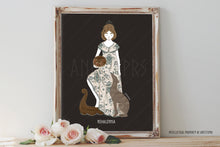

Beginning sometime near the second century BC the Goddess Nehalennia was honored where the Rhine river met the North Sea. Votive inscriptions and numerous altars were dedicated to Her and temples built in Her honor. Sometime after the third century CE Her temple was covered by the ocean where it rested undisturbed for more than a thousand years.
In 1645 a storm on the coast of Zeeland eroded away the land and unearthed Her temple once again. Since then the altars inscriptions and offerings to Her have been studied carefully archaeologists attempting to rediscover Her secrets. Not only that but She has managed to recapture the imagination of the local populace. A new temple to Her was built in the town of Colijnsplaat in 2005.
What’s in a name? Often there’s some information about the attributes of a deity to be found in Their name. From Nehalennia we know that She is likely either a Germanic or Celtic Goddess. That’s where the agreement of scholars ends. Rudolph Simek in his Dictionary of Northern Mythology gives a possible etymology as relating to the Latin verb ‘necare’ which means ‘to kill’.
Kauffmann believes it relates to *neu a word for ship. This relates to many of the inscriptions found dedicated to Her which tend to be merchants thanking Her or petitioning Her for safe passage across the sea. There are also frequently boats depicted on Her altars. There is no clear translation or etymology for Nehalennia however.
On the votive inscriptions that have been unearthed there is a great deal of symbolism associated with Nehalennia. The most popular seems to be fruits and verdant growing things. Baskets of apples frequently appear next to Her or in Her hands and fruit trees and growing vines cover the sides of many of the votive altars. This fits with Her as a Goddess of merchants: peace and prosperity are ideal when your occupation is buying and selling goods.
Interestingly there are a few other symbols frequently associated with Her. One of these is a dog a greyhound-like animal. It is frequently depicted sitting at Her feet looking up at the Goddess. Rudolph Simek connects this iconography with a goddess of the dead. Hilda Ellis Davidson in her Roles of the Northern Goddess argues that the dog is often depicted alongside mother Goddesses particularly in the Roman period in Celtic areas. I personally believe this interpretation makes more sense with the rest of Her iconography but there is an interesting connection there.
Nehalennia is sometimes depicted with Her foot on the bow of a ship. This makes sense with the inscriptions She is clearly seen as having some authority over whether or not ships make it safely across the North Sea. The sea and specifically sea-trade is associated with prosperity in the same way Njord is associated with both prosperity and the sea.




